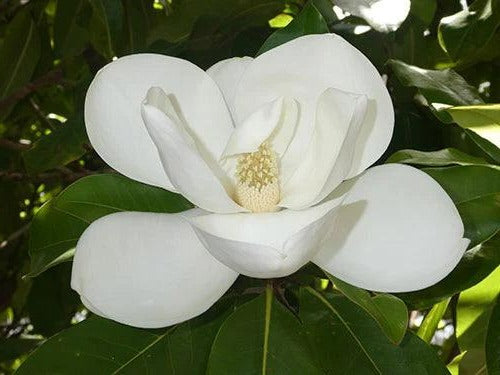Description
Description
The Magnolia grandiflora ‘Bull Bay’, commonly known as the Bull Bay Magnolia, is a stately evergreen tree admired for its large, glossy green leaves with velvety brown undersides and fragrant, creamy white flowers. Blooming from late spring to summer, its flowers can reach up to 25 cm in diameter, adding a dramatic and elegant touch to landscapes. Growing up to 15–20 meters tall and 8–10 meters wide, it is ideal as a feature tree, shade tree, or in expansive gardens and parks.
Specifications:
- Height: 15–20 meters
- Width: 8–10 meters
- Native to: USA (Southeastern United States)
- Foliage: Large, glossy green leaves with bronze-brown undersides; evergreen
- Growth rate: Moderate
Conditions:
- Soil: Prefers well-drained, fertile soils; tolerates sandy, loamy, and clay types
- Light: Full sun to partial shade
- Water: Moderate; requires regular watering during establishment
- Climate: Thrives in temperate, subtropical, and Mediterranean regions
Additional Features:
- Flowers: Large, creamy white, fragrant blooms; late spring to summer
- Form: Upright growth with a broad, symmetrical canopy
- Uses: Ideal as a feature tree, shade tree, or in large landscapes
- Spacing: Plant 8–10 meters apart for individual displays or rows
- Low Maintenance: Requires little pruning; remove deadwood as needed
- Pest Resistance: Generally pest-free; highly resilient
- Drought Tolerance: Moderate once established; thrives with consistent moisture in dry periods
- Wildlife Attraction: Flowers attract bees, while dense foliage provides shelter for birds
- Seasonal Appeal: Evergreen foliage with seasonal floral displays
- Longevity: Long-lived tree, adding lasting beauty to gardens and landscapes
The Bull Bay Magnolia is a grand and enduring tree, perfect for creating a bold, elegant presence and providing shade and fragrance in large-scale gardens and landscapes.
Delivery Information
Delivery Information
We offer flexible delivery options to ensure your tree arrives in perfect condition, whether you're located nearby or on the other side of the world.
- Domestic Deliveries:
We provide reliable delivery services across the country, utilizing our fleet of specialized trucks and train freight networks. Whether you're in a metropolitan area or a remote location, we ensure your trees arrive safely and efficiently. - International Deliveries:
For our global customers, we coordinate delivery via sea freight. With 30+ years of exporting experience, every tree is carefully prepared to meet international biosecurity standards and packaged for safe transport to its destination.
Our team will work closely with you to arrange the most suitable delivery method based on your location, project timeline, and tree size. No matter where you are, we ensure a seamless delivery experience.
Have additional questions? Contact us to discuss your specific delivery requirements!
FAQ's
FAQ's
How are ex-ground trees prepared for delivery?
All ex-ground trees are carefully dug with their rootball intact to preserve the root system and minimize transplant shock. Each tree is stabilized and treated with specialized solutions to promote health during transit. The rootball is wrapped to retain moisture and protect it from damage, and water crystals are added to provide essential nutrients and hydration for the journey. These meticulous preparations ensure your tree remains healthy and ready for planting, whether it’s traveling across the country or overseas.
How long does delivery take?
Delivery times vary depending on your location and the size of your order. Domestic deliveries typically take 1–2 weeks, while international shipping may take several weeks depending on the destination. Contact us for specific timelines.
Are there minimum order quantities for delivery?
For local and nationwide orders, there are no strict minimums, though delivery costs may vary based on order size. For international orders, a minimum quantity is often required to optimize freight efficiency. Contact us to discuss your needs.
Do you provide installation services?
While we focus on the supply and delivery of trees, we can connect you with trusted landscaping partners who specialize in tree installation and site preparation.
Can I visit your farms to select trees?
Yes, we welcome visits to our farms by appointment. Seeing the trees in person allows you to select the perfect specimens for your project. Contact us to schedule a visit.



 Inspection available upon request
Inspection available upon request
 Photos are of example stock
Photos are of example stock
 International Delivery Available
International Delivery Available
 Available For Export
Available For Export
